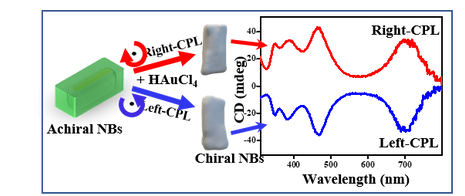
Markovich Lab
Our Research
-
Symmetry breaking in the formation of intrinsically chiral nanocrystals
-
Interaction of chiral molecules with achiral inroganic nanoparticles studied through chiroptical spectroscopy.
-
Using chiral light (circularly polarized light) to induce chiral symmetry breaking in the shape of achiral metal nanoparticles.
1. Symmetry breaking in the formation of intrinsically chiral nanocrystals:
We study nanocrystals with intrinsic chiral structure, i.e. they crystallize with chiral space-group symmetry (chiral unit-cell). We have previously shown that for several types of such materials, including α-HgS, Te, Se, TbPO4·H2O, all crystallizing at the same space-group as quartz (P3121/P3221 for right/left screw axis), we can break the symmetry of forming 50%:50% right:left handed nanocrystals and obtain a significant enantiomeric excess using chiral ligands which would direct the nucleation of the nanocrystals towards a preferred enantiomer.
For example, in the case of TbPO4·H2O nanocrystals, we have shown that 100% enantiomeric excess can be achieved using enantio-pure tartaric acid as the handedness directing ligand. This system also exhibits chiral amplification, where even non-enantio-pure tartaric acid molecules (say, enantiomeric excess >50%) may cause full enantio-selection of the product nanocrystals, or seeding a very small emount of enantio-pure nanocrystals into a synthesis that does not include tartaric acid, would cause all the formed nanocrystals to have the same handedness as the seed particles.
In the case of tellurium nanocrystals, we have also shown that the shape of the nanocrystals may become chiral (kind of twisted trigonal prisms) on the 100 nm scale in addition to the atomic scale chiral crystal unit cell. Similar chiral structures were also found to occur for α-HgS.
The enantiomeric excess of the nanocrystal solutions was probed by either circular dichroism spectroscopy (for α-HgS, Te, Se,), or circularly polarizd luminescence (for TbPO4·H2O), where in both cases a calibration of the magnitude of optical activity vs. enantiomeric excess is needed in order to properly quantitate the obtained enantiomeric excess.
2. Interaction of chiral molecules with achiral inroganic nanoparticles studied through chiroptical spectroscopy.
A major part of our work in nanoscale chirality is about connecting chiral molecules with inorganic nanostructures in various ways. We are primarily interested in chiroptical properties of such hybrid structures. The main spectroscopy technique that we use is circular dichroism (CD).
A typical system that we study is a colloidal noble metal (gold, silver) nanoparticle with strong surface plasmon excitations or a semiconductor quantum dot with discrete electron-hole excitations coated with chiral (bio)molecules, such as amino acids. In many cases we observe circular dichroism peaks at wavelengths corresponding to electronic transitions of the inorganic core (plasmons, excitons). Our aim is to study and understand the mechanisms leading to the induction of the chiroptical effects in the nanocrystal cores. We believe that circular dichroism spectroscopy of such systems may reveal new information on the interaction of molecules with metal and semiconductor surfaces and about the molecular conformation at these surfaces.
3. Using chiral light (circularly polarized light) to induce chiral symmetry breaking in the shape of achiral metal nanoparticles.
The latest study in our lab aims at forming chiral shapes out of achiral plasmonic colloidal nanostructures. The idea here is that on illumination of certain geormetries, such as elongated nanocuboids, with circularly polarized light, asymmetric plasmon resonance patterns could be excited at certian wavelengths. Those asymmetric excitations could be used to deposit (or remove) metal asymmetrically around the nanoparticles and thus convert them into chiral ones.
We have recently shown that a particular chemical reaction that is strongly affected by localized plasmonic excitations with circularly polarized light is the galvanic replacement reaction (GRR) of silver with gold and that chiral plasmonic nanocuboids can be created through GRR in solution when illumination even when the direction of the nanoparticles constatntly varies as they rotate in solution.

3D electron tomography reconstruction of a Te nanocrystal with chiral shape. Its length is about 150 nm.

Model of α-HgS chiral unit cell and TEM image of nanocrystal made of this material.

When chiral cystein molecules are adsorbed at the surface of colloidal quantum dots, made of CdSe, for example, circular dichroism (CD) signals appear at exciton transitions of the quantum dots. The derivative type lineshape indicates exciton state splitting due to the interaction of the chiral molecules and exciton states.
